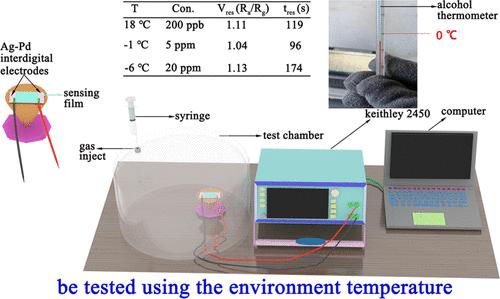Our official English website, www.x-mol.net, welcomes your
feedback! (Note: you will need to create a separate account there.)
Fabrication and Computational Study of a Chemiresistive NO2 Gas Sensor Based on the Carbon Dots-WO3 Heterostructure for Operating below Room Temperature
ACS Sensors ( IF 8.2 ) Pub Date : 2023-02-07 , DOI: 10.1021/acssensors.2c02291 Wengang Bian 1, 2 , Hongrui Dou 1, 2 , Xin Wang 1 , Chunjie Li 1 , Yucai Zhang 1, 2 , Chengyi Gong 1 , Na Sun 1, 2 , Shasha Liu 3 , Ping Li 3 , Qiang Jing 1, 4 , Bo Liu 1
ACS Sensors ( IF 8.2 ) Pub Date : 2023-02-07 , DOI: 10.1021/acssensors.2c02291 Wengang Bian 1, 2 , Hongrui Dou 1, 2 , Xin Wang 1 , Chunjie Li 1 , Yucai Zhang 1, 2 , Chengyi Gong 1 , Na Sun 1, 2 , Shasha Liu 3 , Ping Li 3 , Qiang Jing 1, 4 , Bo Liu 1
Affiliation

|
For a long time, chemiresistive gas sensors based on metal oxide semiconductors (MOSs) suffer from higher operating temperatures, resulting in higher energy consumption and instability of the sensors. Generally, a MOS-based chemiresistive gas sensor being able to work at room temperature is considered to be outstanding already. Here, a highly sensitive NO2 gas sensor based on the carbon dots-WO3 heterostructure, which can work below room temperature at –6 °C, is fabricated. At 18, –1, and –6 °C, its detection limits are 200 ppb, 5 ppm, and 20 ppm, respectively, and the corresponding response values (Ra/Rg) are 1.11, 1.04, and 1.13, respectively. The sensor exhibits good selectivity, stability, and linearity between relative humidity and response values too. A peculiar response behavior was observed. Toward oxidizing gas NO2, the resistance of the sensor based mainly on n-type WO3 shows decrease behavior. Its peculiar response behavior and strong gas sensing ability at lower temperatures were elucidated theoretically using the results of first-principles calculations. The reduction of NO2 into NO by surface oxygen vacancies of WO3 and the following adsorption of NO on the surface of WO3 lead to electron transfer from NO to WO3, and the Fermi level shifts toward the conduction band, making the sensor exhibit the peculiar response behavior. The stronger adsorption capability of carbon dots toward NO2 and a synergistic effect of carbon dots and WO3 together make the sensor capable of working at lower temperatures and own higher sensitivity.
中文翻译:

基于碳点-WO3 异质结构的化学电阻式 NO2 气体传感器的制造和计算研究,可在室温以下工作
长期以来,基于金属氧化物半导体 (MOS) 的化学阻性气体传感器工作温度较高,导致能耗较高且传感器不稳定。通常,能够在室温下工作的基于 MOS 的化学电阻气体传感器已经被认为是出色的。在这里,制造了一种基于碳点-WO 3异质结构的高灵敏度NO 2气体传感器,它可以在低于室温的– 6 °C下工作。在18、–1、–6 ℃时,其检出限分别为200ppb、5ppm、20ppm,相应的响应值(R a / R g) 分别为 1.11、1.04 和 1.13。该传感器在相对湿度和响应值之间也表现出良好的选择性、稳定性和线性。观察到一种特殊的响应行为。对于氧化气体NO 2 ,主要基于n型WO 3的传感器的电阻表现出降低行为。利用第一性原理计算的结果从理论上阐明了其在较低温度下的独特响应行为和强大的气敏能力。WO 3的表面氧空位将NO 2还原为NO ,随后NO在WO 3表面的吸附导致电子从NO转移到WO 3,并且费米能级向导带移动,使传感器表现出奇特的响应行为。碳点对NO 2较强的吸附能力以及碳点与WO 3的协同作用使得该传感器能够在较低的温度下工作并具有较高的灵敏度。
更新日期:2023-02-07
中文翻译:

基于碳点-WO3 异质结构的化学电阻式 NO2 气体传感器的制造和计算研究,可在室温以下工作
长期以来,基于金属氧化物半导体 (MOS) 的化学阻性气体传感器工作温度较高,导致能耗较高且传感器不稳定。通常,能够在室温下工作的基于 MOS 的化学电阻气体传感器已经被认为是出色的。在这里,制造了一种基于碳点-WO 3异质结构的高灵敏度NO 2气体传感器,它可以在低于室温的– 6 °C下工作。在18、–1、–6 ℃时,其检出限分别为200ppb、5ppm、20ppm,相应的响应值(R a / R g) 分别为 1.11、1.04 和 1.13。该传感器在相对湿度和响应值之间也表现出良好的选择性、稳定性和线性。观察到一种特殊的响应行为。对于氧化气体NO 2 ,主要基于n型WO 3的传感器的电阻表现出降低行为。利用第一性原理计算的结果从理论上阐明了其在较低温度下的独特响应行为和强大的气敏能力。WO 3的表面氧空位将NO 2还原为NO ,随后NO在WO 3表面的吸附导致电子从NO转移到WO 3,并且费米能级向导带移动,使传感器表现出奇特的响应行为。碳点对NO 2较强的吸附能力以及碳点与WO 3的协同作用使得该传感器能够在较低的温度下工作并具有较高的灵敏度。






























 京公网安备 11010802027423号
京公网安备 11010802027423号